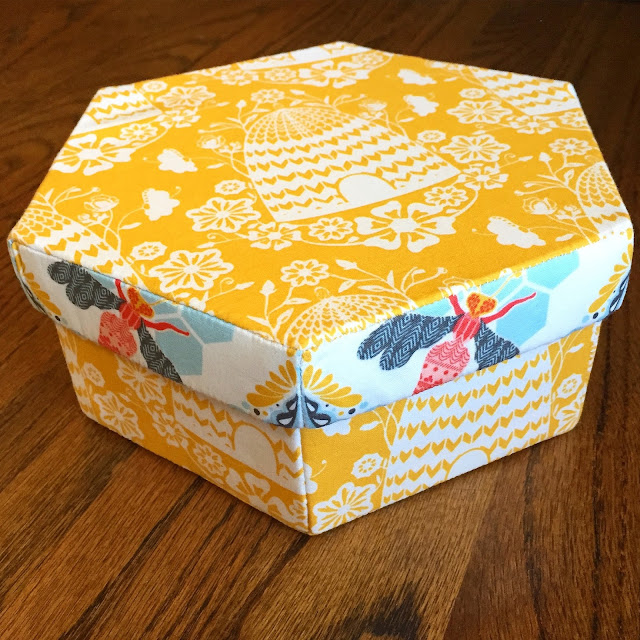A couple of years ago, before I bought my RASKOG cart from IKEA, I made a mini pressing board from a scrap piece of wood in the garage, with a removable, washable cover to use while piecing quilt blocks. After I bought the RASKOG, I learned that my pressing board is the perfect size to fit on top of my RASKOG and create more functional space in my small sewing area. I use both all the time, but for the past several months, my cover has been scorched and ugly. I knew it was time to make a new cover when it transferred brown marks to a hand pieced block I pressed. This time I am making construction notes so I don't have to figure it out when it needs another new one.
Materials:
1" thick piece of wood 11.5" x 16"
Fat Quarter cut into 16" x 21"
Felt or flannel 12.5" x 17"
Insulbrite 12.5" x 17"
Batting 12.5" x 17"
1 package 1/2" extra wide double fold bias tape
1.5 yards of 3/8" elastic (will be cut down to approximately 29" after insertion)
Staple gun
You can use a different size board to make a pressing board, just make your felt/flannel, Insulbrite, and batting an inch bigger in width and length, and your exterior approximately 5" bigger (2.5" on each side) in length and width.
Round edges of the exterior fabric using a bowl as a guide; I used a soup bowl.
Attaching the felt, Insulbrite, and batting:
I skipped over pics of all the pics stretching and stapling the felt/flannel to the wood. I went in this order:
Staple felt or flannel to one long side edge of the board, wrap to the other side and staple, cut square notches at the corners to reduce bulk, then staple the short sides. Make sure to pull taut and smooth to remove any ripples.
Wrap and staple Insulbrite with shiny side up, to the top side of the board in the same manner as the felt.
Repeat with the batting over the top of the board.
It doesn't need to look pretty, just nice and smooth. I chose to staple to the sides of the board, rather than the bottom, to keep from having staples scratch surfaces and reduce bulk on bottom to keep the board flat while pressing. It will look like this when you are done:
Perspective of exterior to board:
Attaching the bias binding:
There are different ways to attach the binding; this is how I did it to make it easier to insert the elastic.
Flip bias binding with the narrow side on top
Open the bias binding on the narrow side, and fold the raw edge down approximately 1/2". Starting on the middle of one long side of the wrong side of the exterior fabric, stitch in the crease of the bias binding.
Work your way around the perimeter, stretching the bias tape around the curves.
Once you reach the beginning, continue sewing for another couple of inches. Back stitch and trim.
Stitching binding and inserting elastic:
The first time I made this cover, I attached a safety pin to the start of my elastic to keep it from moving as I stitched the casing, and then sewed it to the end of the elastic after working my way around. This time I decided to make it even faster. It is on the bottom of the board where no one will see it, so a pretty join is not important to me. I sewed the casing and insert the elastic at the same time. Here is my faster way.
Tack down the end of the elastic near the start/stop of your bias tape on the right side of your fabric. I used approximately 29" of elastic, but kept a much longer length so I wouldn't have to continually stretch the elastic as I sewed. Next time, I will draw a line at the 29" mark so I know how far I need to pull the elastic without fitting it over the board.
Fold bias tape around to front, and cover first stitching line. Stitch near the edge of the bias tape, pushing the elastic to the right. Make sure not to stitch through the elastic; it needs to be free to move inside the casing.
Take special care around the curves.
When your elastic starts getting short, give it a gentle tug and push the casing to the left to reduce the bunching in one spot. Make sure to adjust and flatten your elastic, binding, and the fabric inside the casing as you do this so it doesn't get rumpled as it is stitched. You can see in the pic below where the fabric in the casing is folding and I had to stop and flatten it.
A couple of inches from the start, back stitch and cut your threads.
Gently pull the elastic, and try to make it evenly gathered. It tends to naturally gather more at the corners and that is ok. I put it on the pressing board to get it fairly snug and checked to make sure the cover looked good. Once you have it pulled tightly, attach a safety pin on the end of the elastic so that it cannot get pulled back into the casing.
Leave about 2" extra on the elastic, so that it can overlap the start of the elastic, with some to spare.
Overlap the elastic ends, inserting the cut edge into the casing, and stitch into place across the elastic.
Then sew the rest of the casing. It didn't look perfect, but it was super fast, and better than stapling fabric to the bottom of the board where it can't be removed and can scratch the surface of a table.
And you have a board all ready to use!

































